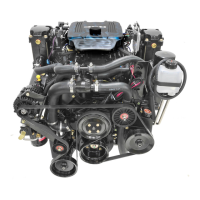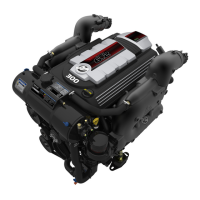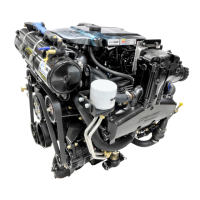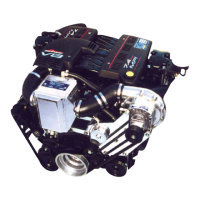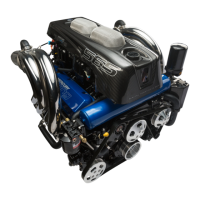• At extremes, can cause the boat to veer back and forth (bow steer)
The Bottom of the Boat
To maintain maximum speed, the boat bottom should be:
• Clean, free of barnacles and marine growth
• Free of distortion; nearly flat where it contacts the water
• Straight and smooth, fore and aft
Marine vegetation may accumulate when the boat is docked. This growth must be removed before operation; it may clog the
water inlets and cause the engine to overheat.
Cavitation
Cavitation occurs when water flow cannot follow the contour of a fast‑moving underwater object, such as a gear housing or a
propeller. Cavitation increases propeller speed while reducing boat speed. Cavitation can seriously erode the surface of the
gear housing or the propeller. Common causes of cavitation are:
• Weeds or other debris snagged on the propeller
• Bent propeller blade
• Raised burrs or sharp edges on the propeller
Ventilation
Ventilation is caused by surface air or exhaust gases that are introduced around the propeller resulting in propeller speed‑up
and a reduction in boat speed. Air bubbles strike the propeller blade and cause erosion of the blade surface. If allowed to
continue, eventual blade failure (breakage) will occur. Excessive ventilation is usually caused by:
• Drive unit trimmed out too far
• A missing propeller diffuser ring
• A damaged propeller or gear housing, which allows exhaust gases to escape between propeller and gear housing
• Drive unit installed too high on transom
Elevation and Climate
Elevation and climate changes will affect the performance of your power package. Loss of performance can be caused by:
• Higher elevations
• Higher temperatures
• Low barometric pressures
• High humidity
For you to have optimum engine performance under changing weather conditions, it is essential that the engine be propped to
allow the engine to operate at or near the top end of the specified maximum RPM range with a normal boat load during your
normal boating weather conditions.
In most cases, recommended RPM can be achieved by changing to a lower pitch propeller.
Propeller Selection
General Information
IMPORTANT: The installed propeller must allow the engine to operate at the specified wide‑open throttle (WOT) RPM range.
The engine operating range is listed in the specification section of the manual.
It is the responsibility of the boat manufacturer or the selling dealer to equip the power package with the correct propeller. Refer
to Propellers http://www.mercurymarine.com/propellers/prop‑selector
.
If full throttle operation is below the recommended range, the propeller must be changed to prevent loss of performance and
possible engine damage. Conversely, operating an engine with a propeller that allows the WOT RPM to reach the limiter, may
cause a warning horn activation and may record the engine over revolution event in the propulsion control module.
After the initial propeller selection, the following common problems may require that the propeller be changed to a lower pitch:
• Warmer weather and greater humidity cause an RPM loss
• Operating in a higher elevation causes an RPM loss
• Operating with increased load (additional passengers, pulling skiers, etc.)
For better acceleration, such as is needed for waterskiing, use the next lower pitch propeller. However, do not operate at full
throttle when using the lower pitch propeller when not pulling skiers.
Because of the many variables of boat design, only testing will determine the best propeller for a particular application.
Available propellers are listed in the Mercury Precision Parts/Quicksilver Accessories Guide.
Section 2 - On the Water
Page 32 90-8M0128973 eng MAY 2017
